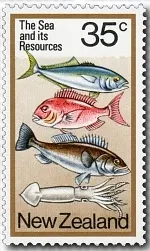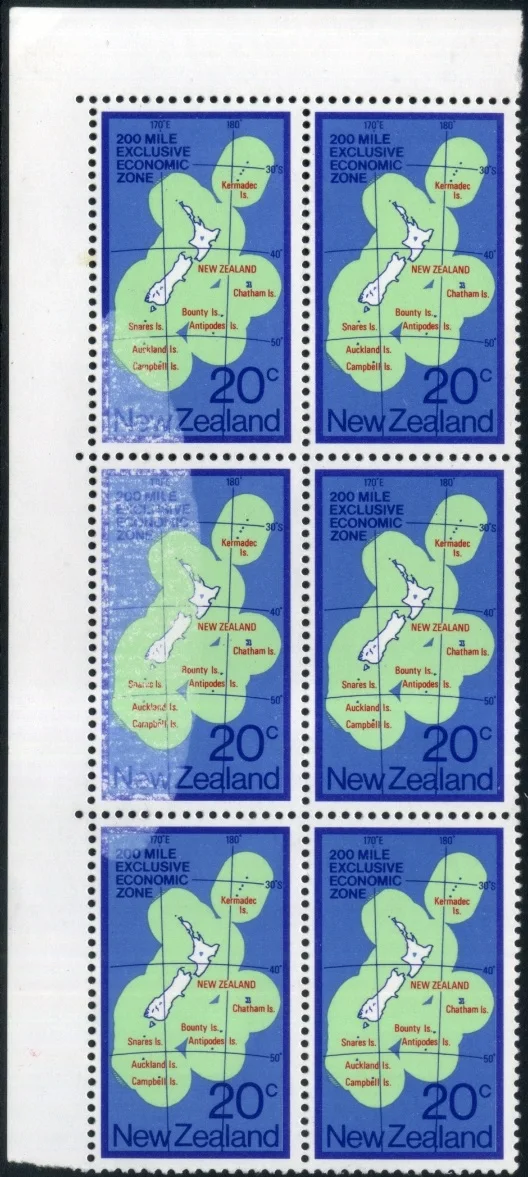As you will probably know, I like stamps which use pictures to display their subject. I think this set is a great example of this from the 1970s. What makes these stamps so good is that drawings were used rather than photographs which would have included too much details for the small area of a postage stamp. Also the decision to use drawings might have been because of technology at that time. The result is they are interesting, clear and easy to understand.
New Zealand is surrounded by oceans and has always been connected with the sea. This stamp issue is about how the country is gaining wealth and produce from the resources of the ocean while at the same time protecting these resources for future generations.
Mineral and Fuel - Maui Gas - 12c
One of the most exciting developments in New Zealand has exploration and discovery of oil and gas. I have followed this closely in my investment activities.
One of the most exciting developments in New Zealand has exploration and discovery of oil and gas. I have followed this closely in my investment activities.
The Maui gas field, among the 20 largest in the world, was discovered in 1969. The 12c stamp show the Maui Natural Gas platform off the coast of South Taranaki. Later a smaller unmanned platform was established over a second section of the gas discovery. Now many years later in 2013 the Maui Gas Field is finally coming to an end.
New Zealand is surrounded the ocean so it is natural we harvest the produce from these oceans. The 15c stamp shows what was a modern fishing vessel in 1978. Today (2013) much larger vessels are common in the oceans around New Zealand. Always the long term goal has been to maintain these fisheries for the future.
200 Mile Exclusive Economic Zone - 20c
Legislation provided New Zealand with a 200 mile (322 km) exclusive economic zone, giving greater control over the resources of the waters surrounding our shores. I am unsure just how effective this has been in stopping vessels from other countries poaching our waters. Over the years Navy, Air force and fishery protection vessels have all been used in the protection of this zone.
Conservation of Marine Mammals - 23c
"Save the whales" has been a campaign cry for some which has been going on since the 1970s. This stamp marks changes in New Zealand in furthering of research and protection of whales and dolphins in the waters around New Zealand.
Fish species - 35c
The final stamp in this issue shows some of the fish taken commercially by the fishing industry. Of course, today (2013) the number of varieties taken has greatly increased. The fish featured on this stamp are kingfish, snapper, groper and squid.
This stamp has become famous for a major colour shift of the blue during printing. The stamp below is an excellent example of this colour shift. Further down this post I have included a joined strip showing this same colour shift.
These three examples of the 35c value all show flaws caused be dirt on the print surface during printing. In the left hand stamp there is round circle half way down the back of the top fish. In the centre stamp a similar flaw can be seen just behind the head of the same fish. On the stamp below these, the flaw is much easier to be seen as a white mark below the "N" in New Zealand at the bottom of the stamp.
A strip five stamps showing the large colour shift we saw above.
1978 20c Sea Resources top left stamp has major flaw caused by foreign object on plate.
1978 Sea Resources 20c value corner selvage block of six stamps. Three of them are affected by printers cleaning fluid removing design in the blue colour.
Technical information
| Date of Issue: | 7 June 1978 |
|---|---|
| Designers: | R M Conly, Christchurch |
| Printers: | Harrison and Sons, England |
| Stamp Size: | 24.13mm x 40.64mm |
| Sheet Size: | 100 stamps per sheet |
| Process: | Lithography |
| Perforation Gauge: | 13.25 x 13.75 |
| Paper Type: | Harrison and Sons, unwatermarked |
Some of the images in this post were used with permission from the illustrated catalogue of StampsNZ
You can visit their web site and On-line Catalogue at, http://stampsnz.com/












We appreciate your engagement with our content. To ensure a respectful and constructive community, please take note of the following:
- No Spam, Please: We do not tolerate spammy or promotional comments. Any such comments will be promptly removed.
- Moderation in Place: All comments are moderated to maintain a positive and inclusive environment. Please be patient, as it may take a little time for your comment to appear.
- Sign In with Google: To comment, please sign in using your Google account. This helps us maintain the integrity of our community and allows for better interaction.